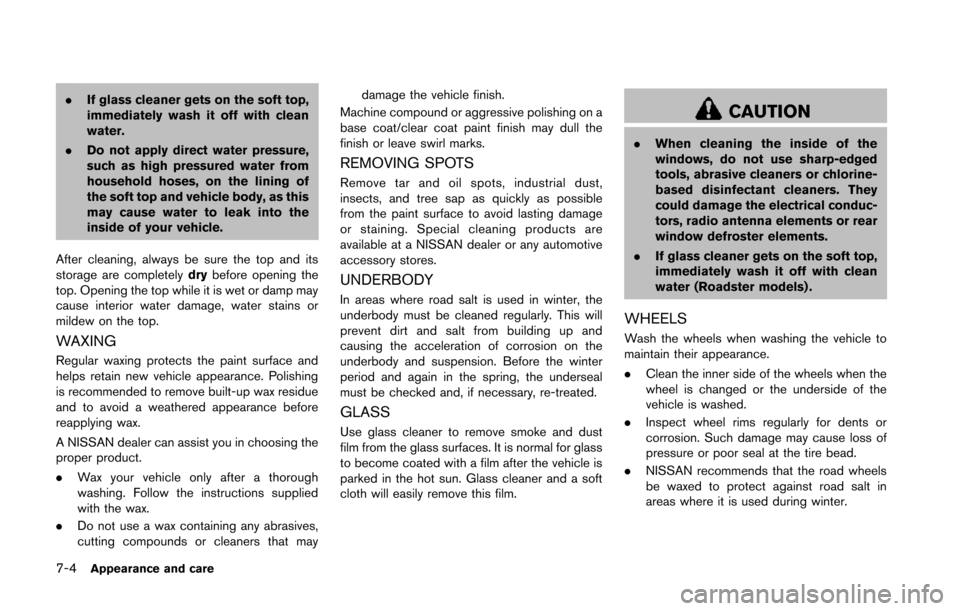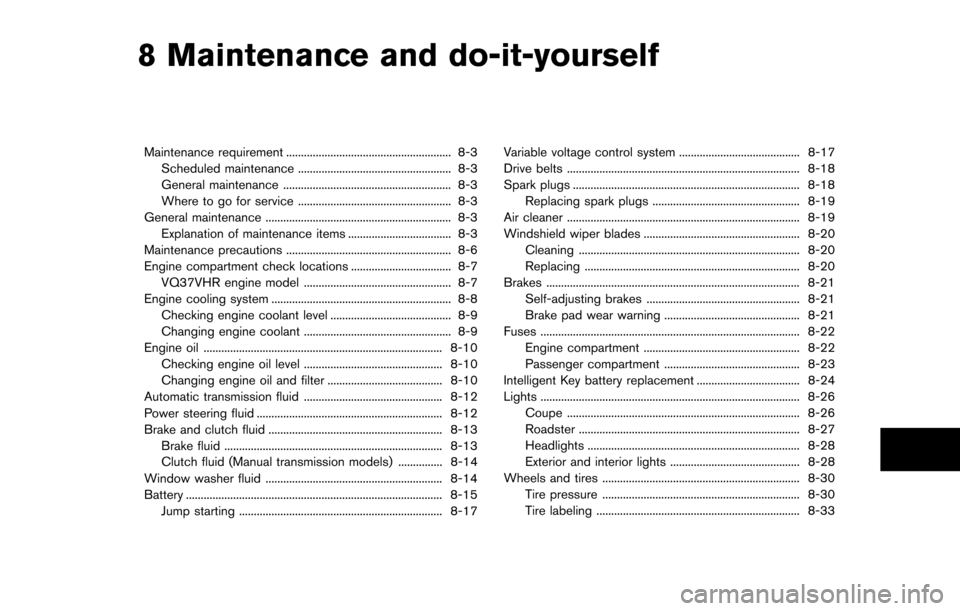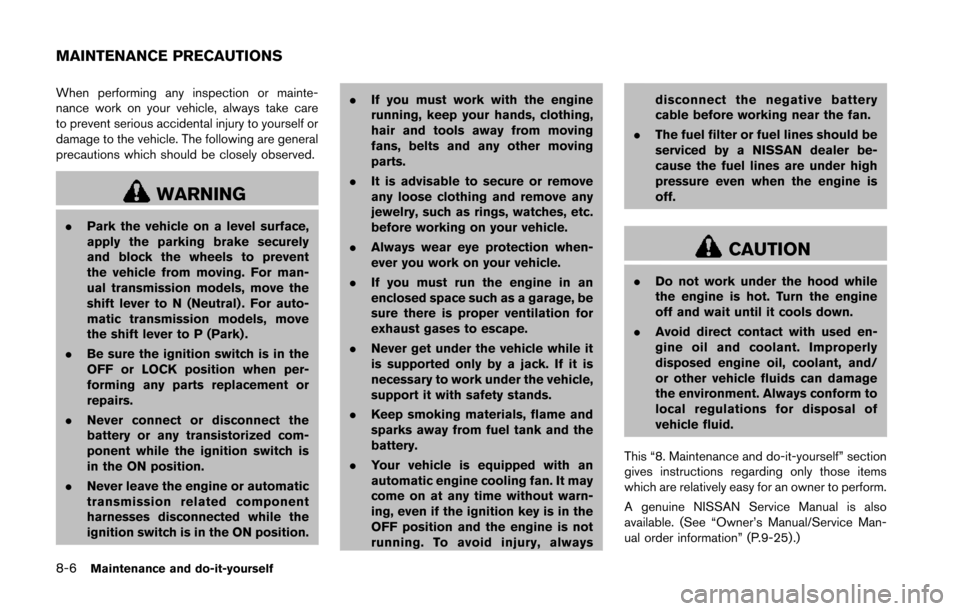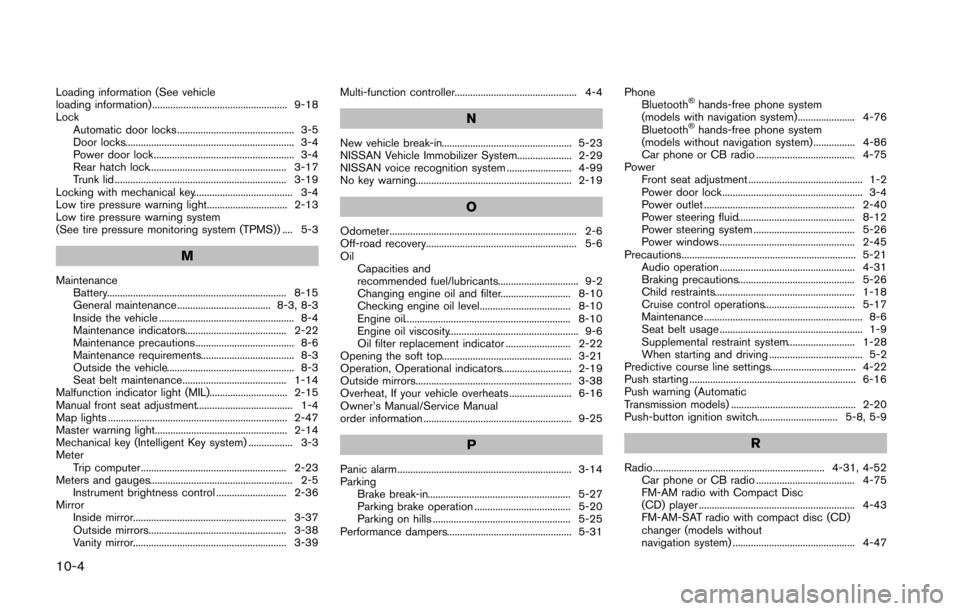2014 NISSAN 370Z ROADSTER oil pressure
[x] Cancel search: oil pressurePage 349 of 428

7-4Appearance and care
.If glass cleaner gets on the soft top,
immediately wash it off with clean
water.
. Do not apply direct water pressure,
such as high pressured water from
household hoses, on the lining of
the soft top and vehicle body, as this
may cause water to leak into the
inside of your vehicle.
After cleaning, always be sure the top and its
storage are completely drybefore opening the
top. Opening the top while it is wet or damp may
cause interior water damage, water stains or
mildew on the top.
WAXING
Regular waxing protects the paint surface and
helps retain new vehicle appearance. Polishing
is recommended to remove built-up wax residue
and to avoid a weathered appearance before
reapplying wax.
A NISSAN dealer can assist you in choosing the
proper product.
. Wax your vehicle only after a thorough
washing. Follow the instructions supplied
with the wax.
. Do not use a wax containing any abrasives,
cutting compounds or cleaners that may damage the vehicle finish.
Machine compound or aggressive polishing on a
base coat/clear coat paint finish may dull the
finish or leave swirl marks.
REMOVING SPOTS
Remove tar and oil spots, industrial dust,
insects, and tree sap as quickly as possible
from the paint surface to avoid lasting damage
or staining. Special cleaning products are
available at a NISSAN dealer or any automotive
accessory stores.
UNDERBODY
In areas where road salt is used in winter, the
underbody must be cleaned regularly. This will
prevent dirt and salt from building up and
causing the acceleration of corrosion on the
underbody and suspension. Before the winter
period and again in the spring, the underseal
must be checked and, if necessary, re-treated.
GLASS
Use glass cleaner to remove smoke and dust
film from the glass surfaces. It is normal for glass
to become coated with a film after the vehicle is
parked in the hot sun. Glass cleaner and a soft
cloth will easily remove this film.
CAUTION
. When cleaning the inside of the
windows, do not use sharp-edged
tools, abrasive cleaners or chlorine-
based disinfectant cleaners. They
could damage the electrical conduc-
tors, radio antenna elements or rear
window defroster elements.
. If glass cleaner gets on the soft top,
immediately wash it off with clean
water (Roadster models) .
WHEELS
Wash the wheels when washing the vehicle to
maintain their appearance.
.Clean the inner side of the wheels when the
wheel is changed or the underside of the
vehicle is washed.
. Inspect wheel rims regularly for dents or
corrosion. Such damage may cause loss of
pressure or poor seal at the tire bead.
. NISSAN recommends that the road wheels
be waxed to protect against road salt in
areas where it is used during winter.
Page 354 of 428

8 Maintenance and do-it-yourself
Maintenance requirement ........................................................ 8-3Scheduled maintenance .................................................... 8-3
General maintenance ......................................................... 8-3
Where to go for service .................................................... 8-3
General maintenance ............................................................... 8-3 Explanation of maintenance items ................................... 8-3
Maintenance precautions ........................................................ 8-6
Engine compartment check locations .................................. 8-7 VQ37VHR engine model .................................................. 8-7
Engine cooling system ............................................................. 8-8
Checking engine coolant level ......................................... 8-9
Changing engine coolant .................................................. 8-9
Engine oil ........................................................................\
......... 8-10
Checking engine oil level ............................................... 8-10
Changing engine oil and filter ....................................... 8-10
Automatic transmission fluid ............................................... 8-12
Power steering fluid ............................................................... 8-12
Brake and clutch fluid ........................................................... 8-13 Brake fluid ........................................................................\
.. 8-13
Clutch fluid (Manual transmission models) ............... 8-14
Window washer fluid ............................................................ 8-14
Battery ........................................................................\
............... 8-15 Jump starting ..................................................................... 8-17 Variable voltage control system ......................................... 8-17
Drive belts ........................................................................\
....... 8-18
Spark plugs ........................................................................\
..... 8-18
Replacing spark plugs .................................................. 8-19
Air cleaner ........................................................................\
....... 8-19
Windshield wiper blades ..................................................... 8-20
Cleaning ........................................................................\
... 8-20
Replacing ........................................................................\
. 8-20
Brakes ........................................................................\
.............. 8-21 Self-adjusting brakes .................................................... 8-21
Brake pad wear warning .............................................. 8-21
Fuses ........................................................................\
................ 8-22 Engine compartment ..................................................... 8-22
Passenger compartment .............................................. 8-23
Intelligent Key battery replacement ................................... 8-24
Lights ........................................................................\
................ 8-26
Coupe ........................................................................\
....... 8-26
Roadster ........................................................................\
... 8-27
Headlights ........................................................................\
8-28
Exterior and interior lights ............................................ 8-28
Wheels and tires ................................................................... 8-30 Tire pressure ................................................................... 8-30
Tire labeling ..................................................................... 8-33
Page 359 of 428

8-6Maintenance and do-it-yourself
When performing any inspection or mainte-
nance work on your vehicle, always take care
to prevent serious accidental injury to yourself or
damage to the vehicle. The following are general
precautions which should be closely observed.
WARNING
.Park the vehicle on a level surface,
apply the parking brake securely
and block the wheels to prevent
the vehicle from moving. For man-
ual transmission models, move the
shift lever to N (Neutral) . For auto-
matic transmission models, move
the shift lever to P (Park) .
. Be sure the ignition switch is in the
OFF or LOCK position when per-
forming any parts replacement or
repairs.
. Never connect or disconnect the
battery or any transistorized com-
ponent while the ignition switch is
in the ON position.
. Never leave the engine or automatic
transmission related component
harnesses disconnected while the
ignition switch is in the ON position. .
If you must work with the engine
running, keep your hands, clothing,
hair and tools away from moving
fans, belts and any other moving
parts.
. It is advisable to secure or remove
any loose clothing and remove any
jewelry, such as rings, watches, etc.
before working on your vehicle.
. Always wear eye protection when-
ever you work on your vehicle.
. If you must run the engine in an
enclosed space such as a garage, be
sure there is proper ventilation for
exhaust gases to escape.
. Never get under the vehicle while it
is supported only by a jack. If it is
necessary to work under the vehicle,
support it with safety stands.
. Keep smoking materials, flame and
sparks away from fuel tank and the
battery.
. Your vehicle is equipped with an
automatic engine cooling fan. It may
come on at any time without warn-
ing, even if the ignition key is in the
OFF position and the engine is not
running. To avoid injury, always disconnect the negative battery
cable before working near the fan.
. The fuel filter or fuel lines should be
serviced by a NISSAN dealer be-
cause the fuel lines are under high
pressure even when the engine is
off.
CAUTION
.Do not work under the hood while
the engine is hot. Turn the engine
off and wait until it cools down.
. Avoid direct contact with used en-
gine oil and coolant. Improperly
disposed engine oil, coolant, and/
or other vehicle fluids can damage
the environment. Always conform to
local regulations for disposal of
vehicle fluid.
This “8. Maintenance and do-it-yourself” section
gives instructions regarding only those items
which are relatively easy for an owner to perform.
A genuine NISSAN Service Manual is also
available. (See “Owner’s Manual/Service Man-
ual order information” (P.9-25).)
MAINTENANCE PRECAUTIONS
Page 423 of 428

10-4
Loading information (See vehicle
loading information) .................................................... 9-18
LockAutomatic door locks ............................................. 3-5
Door locks................................................................. 3-4
Power door lock...................................................... 3-4
Rear hatch lock..................................................... 3-17
Trunk lid .................................................................. 3-19
Locking with mechanical key...................................... 3-4
Low tire pressure warning light............................... 2-13
Low tire pressure warning system
(See tire pressure monitoring system (TPMS)) .... 5-3
M
Maintenance Battery..................................................................... 8-15
General maintenance .................................... 8-3, 8-3
Inside the vehicle .................................................... 8-4
Maintenance indicators....................................... 2-22
Maintenance precautions...................................... 8-6
Maintenance requirements.................................... 8-3
Outside the vehicle................................................. 8-3
Seat belt maintenance........................................ 1-14
Malfunction indicator light (MIL).............................. 2-15
Manual front seat adjustment..................................... 1-4
Map lights ..................................................................... 2-47
Master warning light................................................... 2-14
Mechanical key (Intelligent Key system) ................. 3-3
Meter Trip computer........................................................ 2-23
Meters and gauges....................................................... 2-5 Instrument brightness control ........................... 2-36
Mirror Inside mirror........................................................... 3-37
Outside mirrors..................................................... 3-38
Vanity mirror........................................................... 3-39 Multi-function controller............................................... 4-4
N
New vehicle break-in.................................................. 5-23
NISSAN Vehicle Immobilizer System..................... 2-29
NISSAN voice recognition system ......................... 4-99
No key warning............................................................ 2-19
O
Odometer........................................................................ 2-6
Off-road recovery.......................................................... 5-6
Oil
Capacities and
recommended fuel/lubricants............................... 9-2
Changing engine oil and filter........................... 8-10
Checking engine oil level................................... 8-10
Engine oil................................................................ 8-10
Engine oil viscosity.................................................. 9-6
Oil filter replacement indicator ......................... 2-22
Opening the soft top.................................................. 3-21
Operation, Operational indicators........................... 2-19
Outside mirrors............................................................ 3-38
Overheat, If your vehicle overheats ........................ 6-16
Owner’s Manual/Service Manual
order information ......................................................... 9-25
P
Panic alarm................................................................... 3-14
Parking Brake break-in....................................................... 5-27
Parking brake operation ..................................... 5-20
Parking on hills ..................................................... 5-25
Performance dampers................................................ 5-31 Phone
Bluetooth
®hands-free phone system
(models with navigation system)...................... 4-76
Bluetooth
®hands-free phone system
(models without navigation system) ................ 4-86
Car phone or CB radio ...................................... 4-75
Power Front seat adjustment ............................................ 1-2
Power door lock...................................................... 3-4
Power outlet .......................................................... 2-40
Power steering fluid............................................. 8-12
Power steering system ....................................... 5-26
Power windows .................................................... 2-45
Precautions................................................................... 5-21 Audio operation .................................................... 4-31
Braking precautions............................................. 5-26
Child restraints...................................................... 1-18
Cruise control operations................................... 5-17
Maintenance ............................................................. 8-6
Seat belt usage ....................................................... 1-9
Supplemental restraint system.......................... 1-28
When starting and driving .................................... 5-2
Predictive course line settings................................. 4-22
Push starting ................................................................ 6-16
Push warning (Automatic
Transmission models) ................................................ 2-20
Push-button ignition switch............................... 5-8, 5-9
R
Radio.................................................................. 4-31, 4-52 Car phone or CB radio ...................................... 4-75
FM-AM radio with Compact Disc
(CD) player ............................................................ 4-43
FM-AM-SAT radio with compact disc (CD)
changer (models without
navigation system) ............................................... 4-47
Page 427 of 428

FUEL INFORMATION:
VQ37VHR engine
Use unleaded premium gasoline with an octane
rating of at least 91 AKI (Anti-Knock Index)
number (Research octane number 96).
If premium gasoline is not available, unleaded
regular gasoline with an octane rating of 87 AKI
number (Research octane number 91) may be
temporarily used, but only under the following
precautions:
.Have the fuel tank filled only partially with
unleaded regular gasoline, and fill up with
unleaded premium gasoline as soon as
possible.
. Avoid full throttle driving and abrupt accel-
eration.
Use unleaded premium gasoline for max-
imum vehicle performance.
CAUTION
. Using a fuel other than that speci-
fied could adversely affect the emis-
sion control systems, and may also
affect warranty coverage. .
Under no circumstances should a
leaded gasoline be used, since this
will damage the three way catalyst.
. Do not use E-15 or E-85 fuel in your
vehicle. Your vehicle is not designed
to run on E-15 or E-85 fuel. Using E-
15 or E-85 fuel in a vehicle not
specifically designed for E-15 or E-
85 fuel can adversely affect the
emission control devices and sys-
tems of the vehicle. Damage caused
by such fuel is not covered by the
NISSAN new vehicle limited war-
ranty.
. U.S. government regulations require
ethanol dispensing pumps to be
identified by a small, square, orange
and black label with the common
abbreviation or the appropriate per-
centage for that region.
For additional information, see “Capacities and
recommended fuel/lubricants” (P.9-2) .
ENGINE OIL RECOMMENDATION:
. Genuine NISSAN engine oil or equivalent
. Engine oil with API Certification Mark
. Viscosity SAE 5W-30
See “Capacities and recommended fuel/lubri-
cants” (P.9-2) for engine oil and oil filter
recommendation.
COLD TIRE PRESSURES:
The label is typically located on the driver side
center pillar or on the driver’s door. For
additional information, see “Wheels and tires”
(P.8-30) .
NEW VEHICLE BREAK-IN PROCE-
DURES RECOMMENDATION:
During the first 1,200 miles (2,000 km) of
vehicle use, follow the recommendations out-
lined in the “Break-in schedule” (P.5-23) of this
Owner’s Manual. Follow these recommenda-
tions for the future reliability and economy of
your new vehicle.
GAS STATION INFORMATION